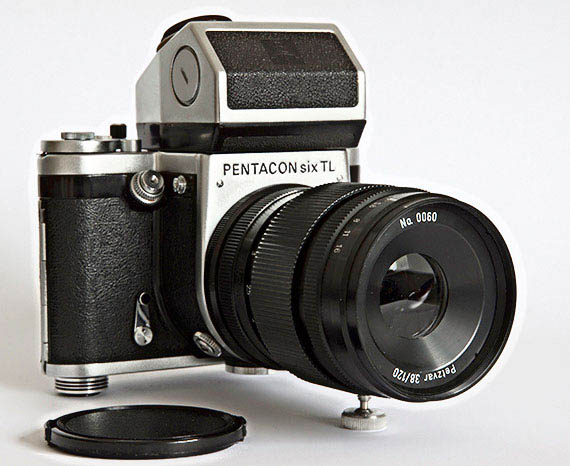
[petz_p6.jpg]
The Pentacon Six System
Lens Data Summary
120mm
Petzvar Portrait Lens: Test results

[petz_p6.jpg]
| What sort of
images does this lens produce? Invanichek speaks
of the Petzvar's "swirly
bokeh and the focus fall off in the off-center areas,
caused by uncorrected astigmatism and chromatic
aberrations." His website shows some sample
images, but at least some of them (and possibly all)
were shot on a 35mm digital camera (a Nikon
D700). Even though this is a full frame 35mm
camera, this means that the sensor is
(approximately) 24mm×36mm, a lot less than the
approximate 54mm×54mm format provided by medium format
film cameras. Technical details of test images All test pictures on this page were shot by me on a Pentacon Six TL, with metering by the normal Carl Zeiss/Pentacon metering prism. They were all shot on the same roll of film: Fuji PRO160NS, which was processed by a professional lab. Images were scanned to the computer from the negatives, using an Epson Perfection V750 PRO scanner driven by the latest version of VueScan, at an original resolution of 6400 dpi. I have been careful to make the same processing adjustments (colour balance, brightness and contrast, etc) to all the images, in order to make valid comparisons, even though some images would benefit from further individual tweaking, to bring out the best in the image. Obviously, images have been reduced massively in size for display on this web page. Lighting was outdoors on a bright summer's day, with no reflectors or other accessories used to reduce contrast or improve shadow detail. The camera was hand-held and images were shot in rapid succession and with minimum guidance for the model. The scans cover the whole of the image on the negative and therefore show significantly more at the edges and corners that can be seen in standard prints from the lab, where the negative holder is designed to mask the edges of the image. If you use a lab to produce prints, or shoot on slide film that is put in standard mounts for projection, you will see less of the image than is visible in these scans. |
| Pictorial
Effect The Petzvar is designed to be used for its overall pictorial effect. Therefore, some of the traditional criteria used in evaluating lenses, such as resolution across the whole of the frame, are obviously not relevant. In this image, we immediately see the expected characteristics of the Petzvar:
The "swirly effect" is rather like a "halo" round the subject's head in this image. It focusses the viewer's attention on the face. At maximum aperture there is a moderate amount of vignetting that is not surprising for this type of lens. In fact, it is a feature of the original Petzvar design and many would consider that it enhances the image, by again subtly focussing the viewer's attention on the subject of the portrait. Interestingly, I didn't tell the subject anything about the characteristics of the lens, and she likes the result. Remember that with the standard cropping of the frame caused by any enlarger or slide mount, the tiny amount of sky that is here visible near the top of the frame would disappear. The image would benefit from cropping this out, but for this test I am showing you the whole of the frame. How does stopping down the lens affect the image? What are the results when shooting from a greater distance? (Note that none of these images have been shot from the closest focussing distance of the lens.) |
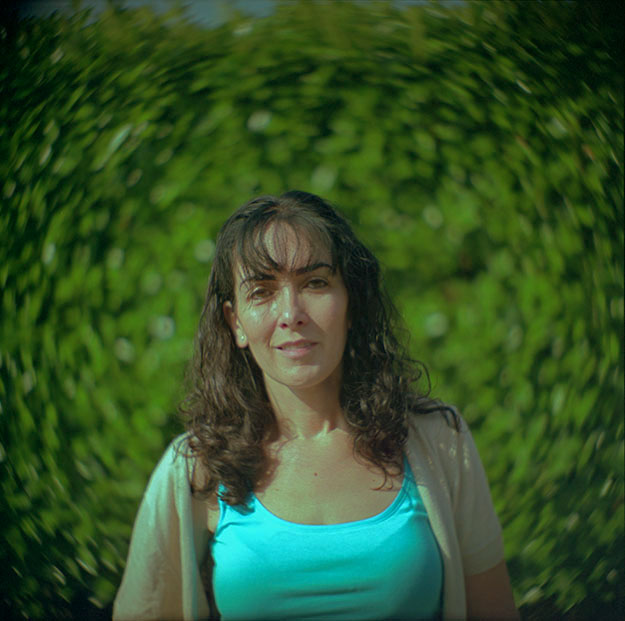 Ivanichek Petzvar at maximum aperture:
f/3.8. Shutter speed: 1/1000 sec
[c533_3.jpg] |
|
With
the lens stopped down
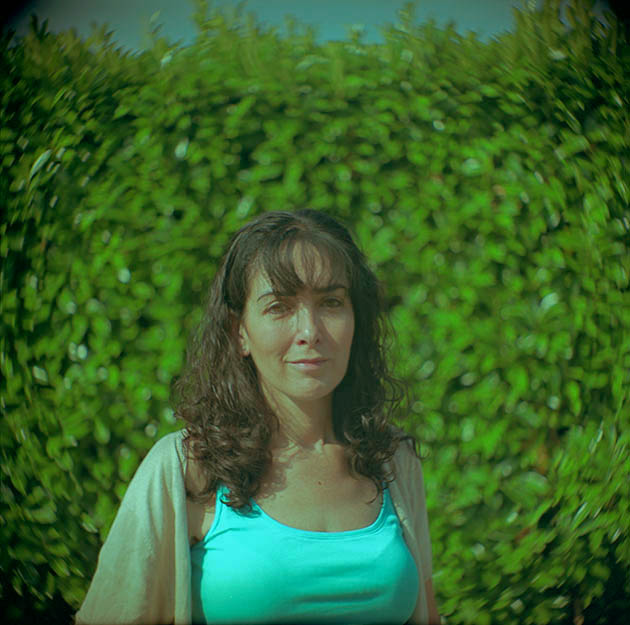 Petzvar at f/8 Shutter speed: 1/125 sec [c533_7] It will be observed that when the lens is stopped down to f/8, the area affected by the vignetting decreases substantially, but the boundary of the vignetted area becomes more obvious. In practice, this would probably be substantially reduced in any print or mounted slide. |
Shooting
from a greater distance
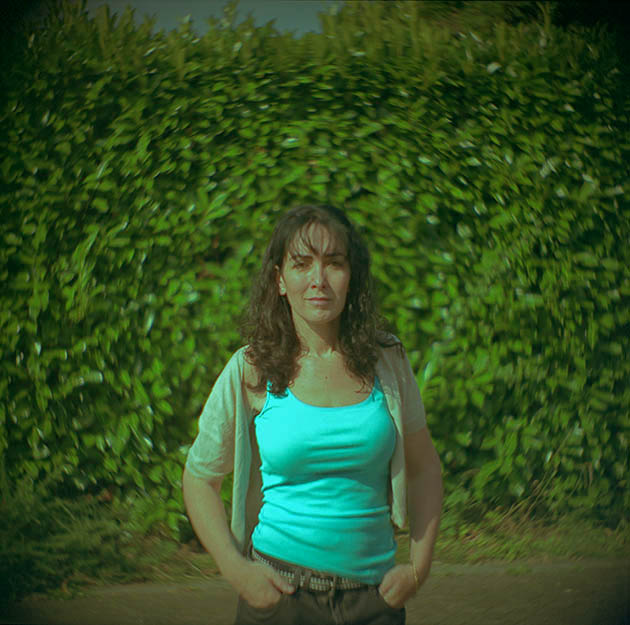 Shooting from a greater distance, once more at maxium aperture Shutter speed 1/1000 sec [c533_13.jpg] Having moved back, I returned the
lens to maximum aperture and adjusted the shutter speed
accordingly. The the limits of the hedge in the
background now become visible. The results are
probably better when that is not the case.
|
Sonnar
at maximum aperture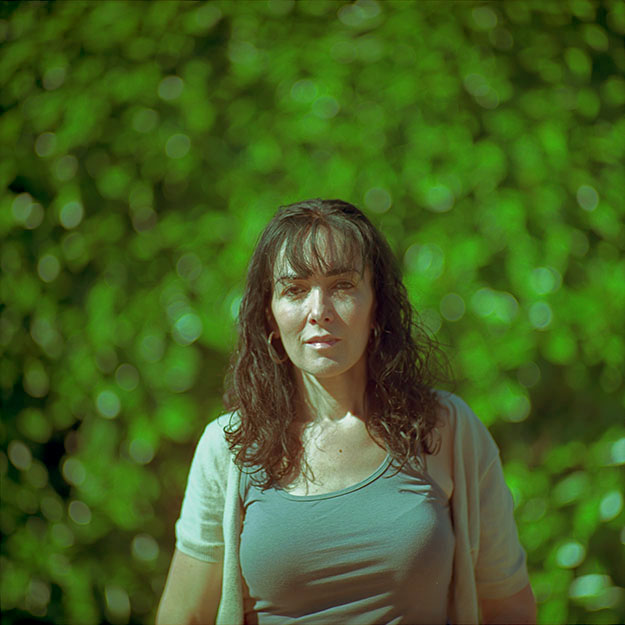 Maximum aperture, f/2.8 Shutter speed: 1/500 [c533_16.jpg] Both of these images were shot the
next day (hence the different-coloured top). It
is immediately clear that the Sonnar images are more
contrasty than the Petzvar images. In fact,
perhaps they are too contrasty; these
two images would have been improved by the use of a
reflector to reduce contrast in the shadow areas and
thus permit a shorter exposure, avoiding the
over-esposure that is evident in the highlight areas.
|
Sonnar
stopped down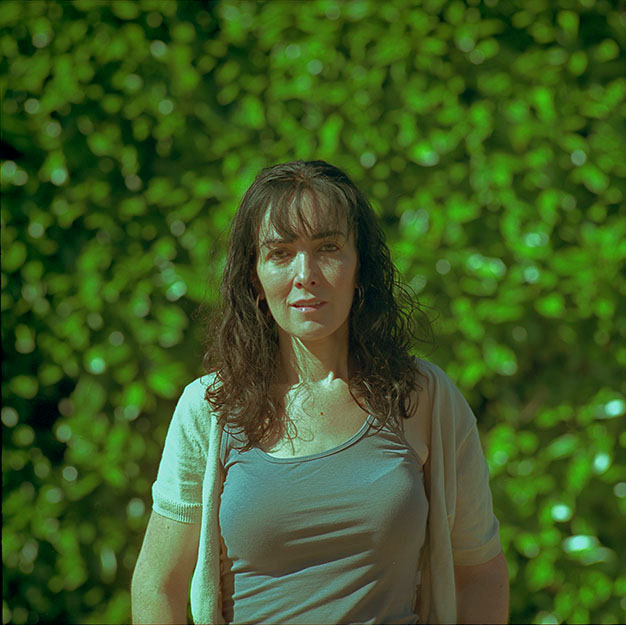 Sonnar stopped down to f/5.6 Shutter speed: 1/500. [c533_17.jpg] The incorrect shutter speed with
this image was due to operator error: the shutter
speed should have been 1/125, but the lattitude of the
film has coped excellently with this. Even so,
the highlighted area on the right arm (left of the
image) is still over-exposed.
The markedly-different bokeh of the Sonnar, at whatever aperture, compared with the Petzvar, is immediately obvious. |
 Petzvar at maximum aperture: f/3.8 [c533_3eyes.jpg] 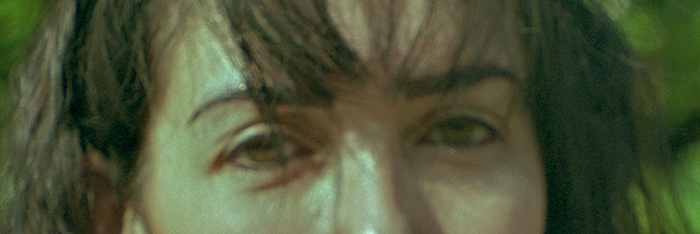 Petzvar stopped down to f/8 [c533_7eyes.jpg] |
 Sonnar at maximum aperture: f/2.8 [c533_16eyes.jpg]  Sonnar stopped down to f/5.6 [c533_17eyes.jpg] |
|
First, three factors must be borne in
mind:
The Sonnar produces images that are sharper and more contrasty than the Petzvar. In fact, perhaps they are too sharp and too contrasty, revealing skin imperfections that in real life we had not even noticed. Thus, the Petzvar produces more pleasing portraits. Of course, excessive contrast can be corrected and excessive sharpness can be reduced. Controlling contrast
Photographers over the years have found various ways of reducing sharpness in portrait photography.
|
| Conclusion The original Petzvar lenses were principally used for portraits, and many would view the optical effects caused by this new Petzvar lens as highly desirable for such images, in spite of its obvious optical flaws. The central area is indeed optimally sharp for portraits. 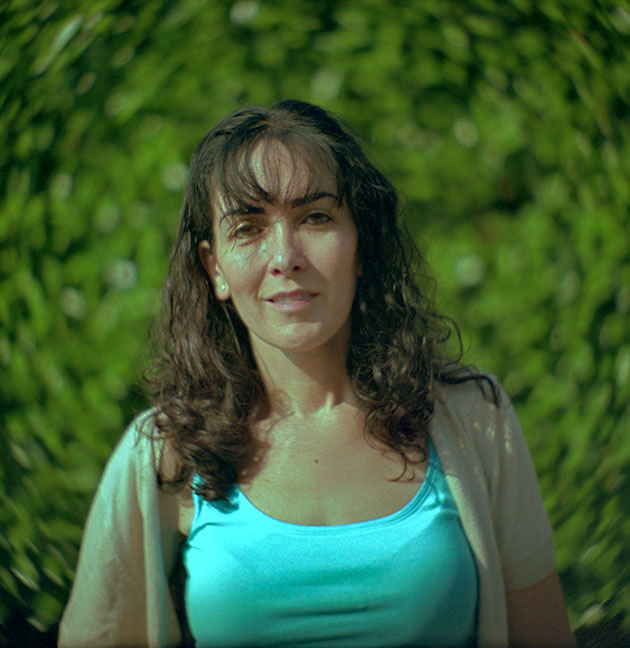 A full-aperture Petzvar image with a small degree of cropping [c533_3cp.jpg] Before making this minor crop, I could have straighted up the head, but this is not a passport photo; I think that the subject looks more at ease with her head at a slight, natural tilt. |
To go on to the next
section, Kilfitt/Zoomar lenses, click here.
© TRA August 2015, rev September 2015